How To
Total War: Three Kingdoms – Complete beginner’s guide

- July 12, 2019
- Updated: March 16, 2024 at 7:55 AM

Ruling a kingdom is hard. Establishing a kingdom to rule is even harder. Maintaining a hard-won kingdom while competing to rule an empire? That’s not for the faint of heart.
In Total War: Three Kingdoms you’ll take on the mantle of one of 12 (15 if you include the Yellow Turban DLC) faction leaders, with one ultimate goal in mind: become the Emperor, defend your claim to the title, and unify China under your singular banner. Whether you achieve this largely through peaceful diplomacy, shrewd trade, a cunning network of spies, or through military conquest is up to you; there are many paths to the throne.
Whether you’re new to Total War: Three Kingdoms or are new to the Total War franchise as a whole, this is the guide for you. Check out these 10 beginner tips and you’ll be min/maxing commanderies and scoring decisive victories like you were born with a glaive in hand.
What Is Total War: Three Kingdoms?
Total War: Three Kingdoms is a turn-based strategy game by Creative Assembly and published by Sega. This game is available on Windows and is the 12th mainline entry of the Total War series.
In the game, you can choose between 12 different warlords and attempt to conquer China. You can recruit ancient heroes with exceptional abilities to aid your cause and help you achieve your goals.
The storyline is very compelling, and all the warlords and heroes have their own backstories, skills, and uses. Choosing who you’ll play at will significantly affect how you experience the game, so make sure to select a character that resonates with your playing style.
In this Total War: Three Kingdom guide, we’ll be covering more about the game, how it works, and we’ll even share some helpful Three Kingdom tips to get you started.
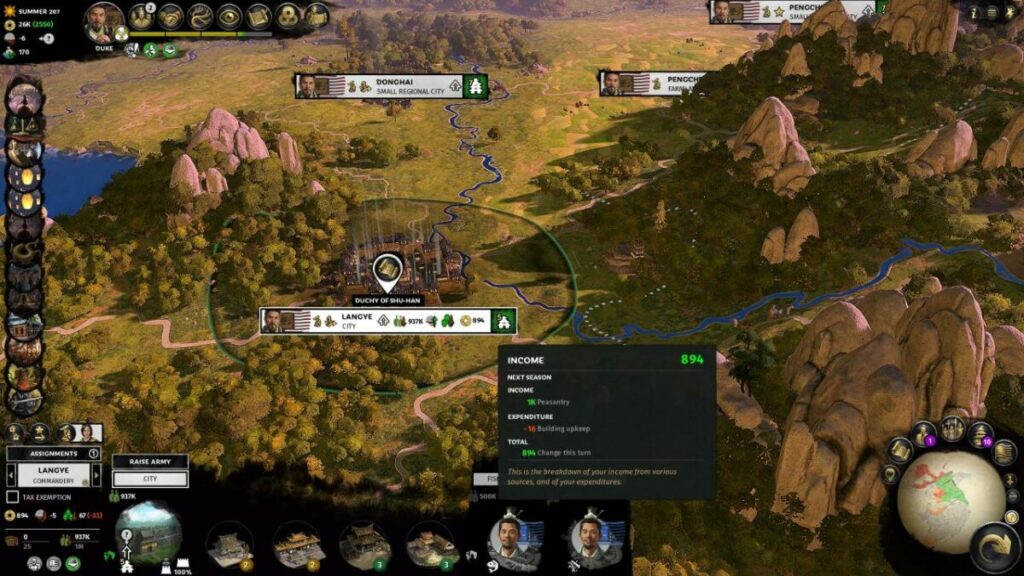
How to Play Total War Three Kingdoms?
Total War: Three Kingdoms is a turn-taking strategy game. This means that you can make decisions and adjust your strategies as each turn goes by. Hopefully, this will lead to success in your quest and battles.
During the gameplay, you’ll get opportunities to move your various troops in strategic battles against the opposition. This is where the strategy comes in, and you’ll have to use the suitable types of soldiers against the enemy to get the advantage. Your heroes can use their unique abilities to support your troops or to duel it out with other commanders to end the battle.
This is not purely a game centered on battle strategy. You also have to gather resources to keep your generals and troops sustained during battle and the travels across the continent in a quest for complete domination.
Here are some tips and tricks for Total War: Three Kingdoms.
1. Prestige is key
You can’t make a claim for Emperor without climbing up the hierarchy, and you can’t climb that ladder without earning prestige. Once you load up your first campaign (we recommend starting with Cao Cao, Sun Jian, or Liu Bei) you’ll get a few missions (like conquering the Han, for instance), but the game will quickly stop holding your hand once you start making progress. As such, it’s easy for novice players to lose sight of what you’re supposed to be doing.
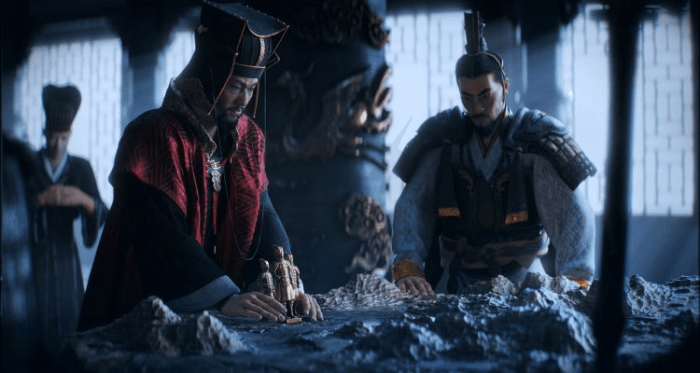
The way to win any of the campaigns in Total War: Three Kingdoms is to unite and rule over all of China. While there are many types of currency in the game like gold or food, the only one that progresses you to the win state is prestige, which lets you rise to claim higher titles, eventually culminating in a battle for the title of Emperor. Prestige is earned through taking enemy commanderies and expanding your territory, and slowly covering the map with your flag and your flag only.
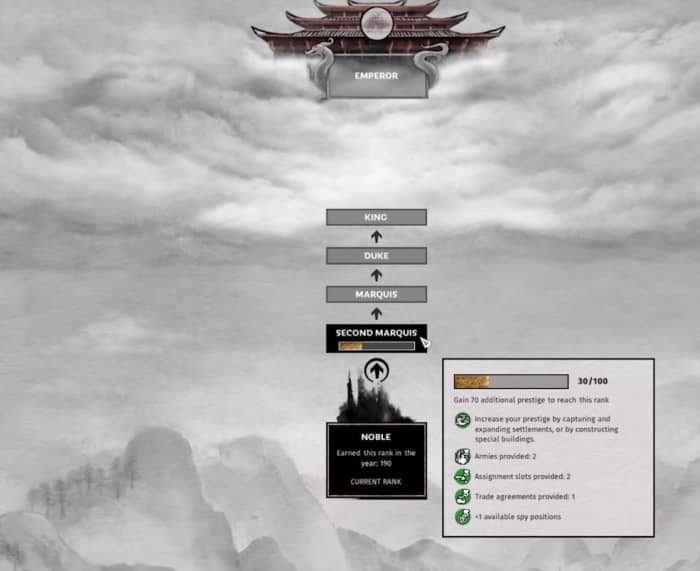
2. Know your attributes
Let’s simplify this tip even more: The characters at your command mean everything – your court, your family, your commanderies (cities), your armies, and your very administration. Every character has a set of attributes which grow and change, depending on how you mold them. These attributes are color-coded per character, and everyone has their strengths and weaknesses. The attributes are:
Authority (yellow): Authority connotes leadership in Three Kingdoms, and represents a general’s ability to lead others both on and off the battlefield. Politically these characters are good at boosting satisfaction. When fighting they’re great at keeping your units’ morale high.
Cunning (blue): Blue characters are used for strategy and planning (and also make good spies), but generally aren’t great in a fight. They are, however, exceptionally good when leading ranged units, and in Three Kingdoms archers reign supreme, so don’t discount these archetypes from your armies! Characters with high cunning also grant troops in their retinue more ammunition and overall military supplies.
Instinct (red): Red is the color of blood and valor and as such designates a character’s military might and battle prowess. These generals excel at melee combat and belong on the front lines, particularly when leading a shock cavalry charge. Don’t forget that higher instinct levels also mean that initial recruitment costs are lower, so these generals can lead bigger mightier armies.
Resolve (green): A high resolve means a high vitality. Raising this attribute will keep your unit alive longer on the battlefield, and will help them boost population (more peasantry = more money!) in commanderies if they’re assigned as administrators. Green characters are also the best duelists, so in battles use them to duel and kill opposing generals to sew terror in enemy ranks.
Expertise (purple): On the battlefield, Expertise is a measure of evasion and defense, making retinues led by a Sentinel very hard to break. They have improved melee defense and work great with shielded infantry and defensive garrisons. Expertise also helps with administering commanderies. A character with high expertise will reduce building costs, which means you have more money to spend on extra upgrades or larger armies.
The five colors yellow, purple, blue, green, and red match the five elements (earth, metal, water, wood, and fire respectively) where each element nurtures another, and is countered by its opposite.

3. Battlefield vs boardroom
With these attributes in mind, the next step is deciding where the officer can best serve you. Do you want them on the field leading a battle? Or would you rather have them administering a city, or out spying on your rivals? Maybe you don’t want them at all, and would be better off marrying them out of your faction for some quick cash and improved relations.
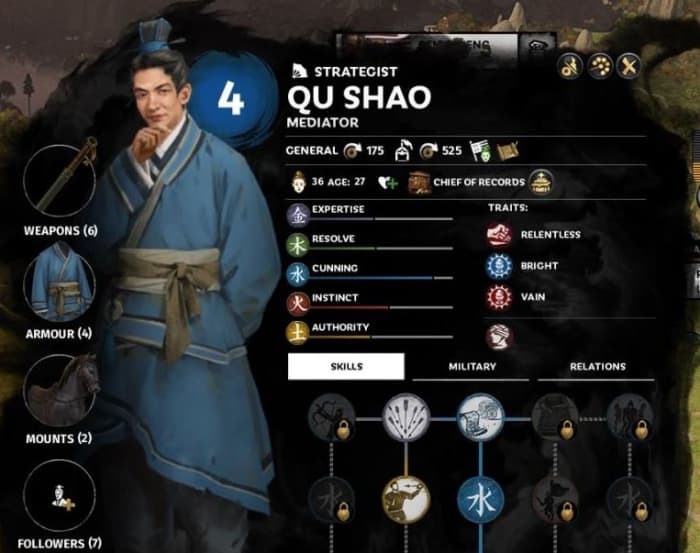
Where you position your characters is important not just for you, but for the characters themselves. In Three Kingdoms, these officers aren’t just pawns on a chessboard; they have unique attitudes, aspirations, and opinions on other officers. For better or for worse, that means they won’t always get along with each other.
If members of your court are in disharmony with each other, things won’t run as smoothly, and satisfaction will drop faster, which can lead to defection or even civil war. Taking someone out of your court and placing them on the battlefield (or at least administering them in a commandery far away) might make everybody happier.

4. Rock paper scissors combat
Like many RTS games, the combat in Three Kingdoms is ‘rock-paper-scissors,’ which means its a system of checks and balances. We said earlier that archers reign supreme, and that’s still true, but they’ll get utterly destroyed by cavalry. Cavalry are great, too, but will meet a swift end if they charge into the pointy ends of enemy spearmen. In general, the order goes like this:
Cavalry > Archers, Melee infantry, Artillery
Melee infantry > Polearm, Archer, Artillery
Polearm > Cavalry
Archers > Polearms
Ranged Artillery > Structures units
Try and line up your units so that they’re in the right place at the right time. Upgrading your units and letting them gain XP over time is a good way to strengthen them, but in the end, it’s more important where they are positioned.

5. Know your faction strengths
While the overall mechanics, gameplay, and goals of each faction remain the same, you’re in for a rough ride if you try to play He Yi and Yuan Shao the same way. Some factions are at home on the battlefield, while others prefer diplomatic manipulation. Leaders like Liu Bei and Yuan Shao prefer noble altruism and favorable coalitions while the likes of Yuan Shu or Dong Shuo are more demanding and tyrannical.

Factions you play will also receive unique perks, units, structures, or sometimes even a unique spendable resource, such as Yuan Shu’s Legitimacy or Cao Cao’s Credibility.
=> Full walkthrough of each faction’s abilities
Of course, different factions begin at different locations as well, so bear in mind the advantages and disadvantages of the terrain modifiers as you make your start.
6. Gold vs Rice
Trade is the lifeblood of diplomacy in Three Kingdoms, and you’ll find yourself wheeling and dealing practically every turn. Don’t be quick to accept deals, though, even if they’re in your favor. Instead, weigh your options carefully.
Another faction may offer you a lump sum of gold for you to join them in a war, but if you’re already loaded with cash, you might be better off asking for something else – like food, ancillaries, military access, or even territory.
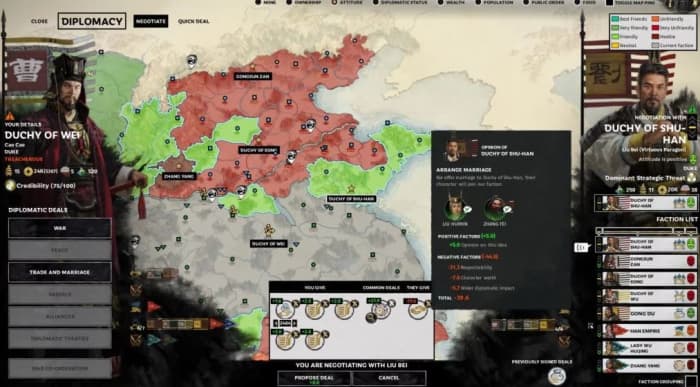
You can make deals of your own too, of course, and it’s worth your while gauging the opinions, politics, and positions of other factions often. This can be especially helpful at the start of the game when you’re trying to keep your economy afloat, build your armies, manage your population, and keep your commanderies defended.
Signing multiple trade agreements and quick deals that grant you income per turn is a great way to generate a positive income to then use on building and upgrading commanderies that will eventually make you self-sufficient.
7. Match your colors
We already went over what each color means, and how that should help dictate where they belong in your growing empire, but the next step is to stack your bonuses to min/max your character to best effect. Various upgrades, ancillaries, followers, and even outfits and weapons can boost a character’s attributes to huge effect.
If your Champion is going against another Champion in a duel, the deciding factor might be which of them has more health and deals more damage. If you spent time stacking Authority and Cunning upgrades on your Champion while the enemy focused on Resolve and Instinct, you’re probably not winning this duel.

8. Consider army composition
When you’re building an army, obviously you want to keep that rock-paper-scissors combat in mind; making sure your archers are defended by pikemen, that you have enough cavalry to flank properly, and that you’ve got enough infantry to surround your otherwise squishy trebuchet.
On a more macro level, though, you also want to consider your generals’ colors again. You can have one general per retinue, and three retinues per army, so what’s the best combination of archetypes for what you’re trying to accomplish with this force? Are you trying to defend your territory? Then be sure to incorporate a Sentinel and a Commander. If you’re trying to lay siege to a large enemy city, though, you’d be better off with a Strategist or a Vanguard.
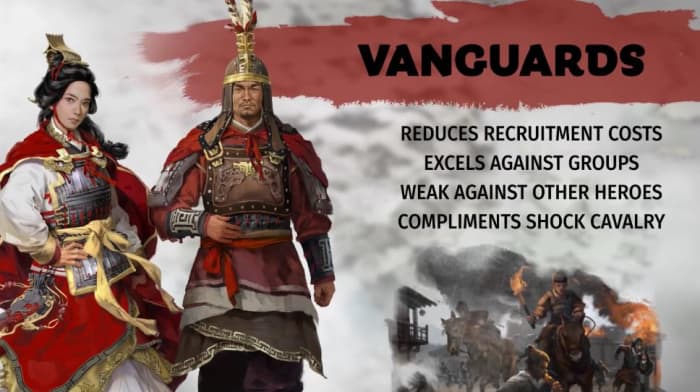
9. Rout and shatter
Make no mistake, you’ll be murdering plenty of units in Three Kingdoms, but if you look at the bigger picture of a battle you’ll quickly realize that killing isn’t actually that important. You’ll more likely win skirmishes by breaking the opponent’s morale.
Overwhelming numbers and coordinated flanking maneuvers can quickly cause panic in enemy units, especially if done with cavalry, and this can cause enemy units to quake, panic, and eventually flee altogether. This buys you time to re-position for another charge, engage the capture point, or move up your squishier units so you wrest more control of the battle.
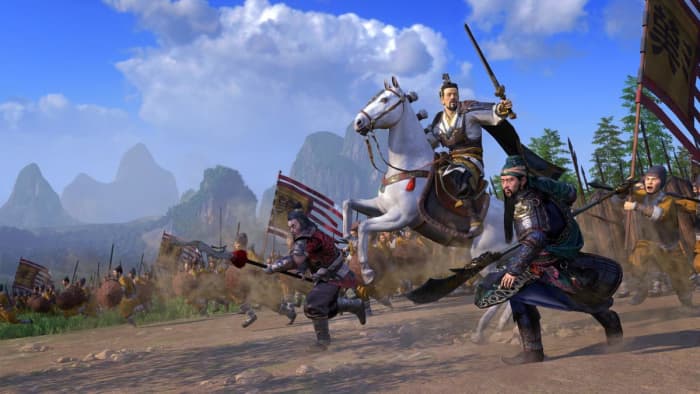
Some officers leading your retinue can debuff enemy troops with morale penalties, which can tactically stack with a well-timed cavalry charge to send foes scattering. Likewise, you can also position your Commanders around your more feeble units to ensure that they benefit from the boosted morale. This will keep your troops on the battlefield even if they’re getting nervous.
10. Two armies can group up
If you’re looking at the total strength of a fully decked-out army in one of enemy capitals and wondering “what’s my advantage if both of us are at full strength?” then you’re not thinking outside the box. There are many ways to weaken an enemy force before the siege (or defense) even begins.
You can manage your stance to plot an ambush, starve out a city while building siege equipment, demand their surrender, or even attack during winter for a seasonal debuff that works both ways. One reliable strategy to boost your numbers is to attack with two armies at once.
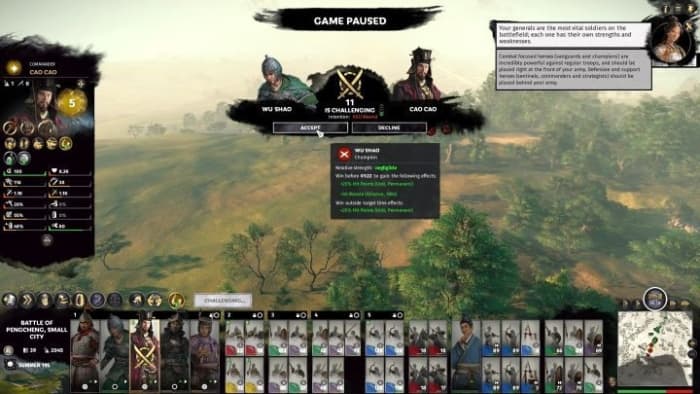
To attack with two armies at once, all you have to do is position your second attack force adjacent to the commandery you’re attacking. When the battle starts you’ll only have access to the army that initiated the battle during the deployment phase. Once the battle officially starts, however, your reinforcements will arrive to join the fight. What this means is that if you plan to use two armies during an engagement, you have a total of six retinues at your disposal, each with their own (color-designated) officer.
If you wanted to, you could have your entire second army comprised of cavalry and vanguards who can storm in and break the enemy line once you’ve engaged them with army 1. Hey, it worked for Gandalf.

Study up, and don’t be afraid to practice in custom battle mode before starting a campaign to get a better feel for the ebb and flow of combat.
You may also like

Sunreef Yachts Unveils Solar Skin 3.0 Technology For Sustainable Yachting
Read more

New Collaboration Ensures Real-Time Updates For Electric Vehicle Charging Locations
Read more

China has an alternative to NVIDIA’s CUDA: What do we know about the new system?
Read more

ChatGPT can turn your pet into a human, with surprising results
Read more

2026 Chevrolet Bolt Shows Off Fresh Design and Upgraded Features
Read more

Pixelating photos to hide data no longer works: AI can extract text and reveal all the secrets
Read more